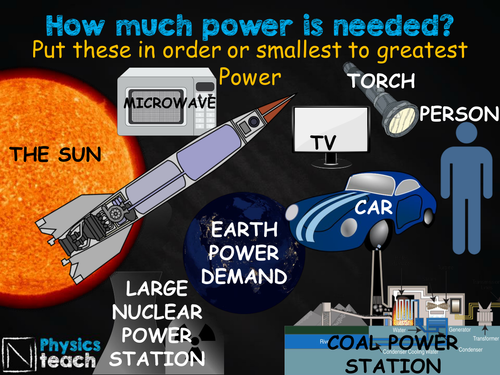


New GCSE AQA Physics lesson on 'Electrical Power and potential difference' written in line with new AQA Physics specification.
Starter looks at the power of different devices of very different orders of magnitude. Following this a quick activity looks at powers and conversion using Watts as the unit to convert - reviews nW, µW, mW, W, kW, MW, GW.
The power and energy transferred equation is reviewed briefly through review questions.
The equation for power using voltage and current is introduced and how to re-arrange it. Fuse ratings are discussed with appropriate choice of fuse rating highlighted.
Energy transfer by heating in conductors/resistors is reviewed and then related to the Power equation using resistance and current. How to re-arrange this is shown in detail.
The lesson concludes with a series of review questions and exam style questions.
Lesson Objectives:
1) State a definition for power.
2) Calculate the power of an appliance by the energy transferred.
3) Relate potential difference and current to electrical power.
4) Identify appropriate fuse ratings for appliances.
5) Identify the uses of resistance in conductors and calculate power using resistance.
Starter looks at the power of different devices of very different orders of magnitude. Following this a quick activity looks at powers and conversion using Watts as the unit to convert - reviews nW, µW, mW, W, kW, MW, GW.
The power and energy transferred equation is reviewed briefly through review questions.
The equation for power using voltage and current is introduced and how to re-arrange it. Fuse ratings are discussed with appropriate choice of fuse rating highlighted.
Energy transfer by heating in conductors/resistors is reviewed and then related to the Power equation using resistance and current. How to re-arrange this is shown in detail.
The lesson concludes with a series of review questions and exam style questions.
Lesson Objectives:
1) State a definition for power.
2) Calculate the power of an appliance by the energy transferred.
3) Relate potential difference and current to electrical power.
4) Identify appropriate fuse ratings for appliances.
5) Identify the uses of resistance in conductors and calculate power using resistance.
Get this resource as part of a bundle and save up to 50%
A bundle is a package of resources grouped together to teach a particular topic, or a series of lessons, in one place.
Something went wrong, please try again later.
Fantastic resources as always
another great resource - thank you
Report this resourceto let us know if it violates our terms and conditions.
Our customer service team will review your report and will be in touch.
£3.00
